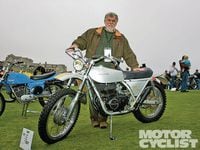I arrived at Motorcyclist in July 1976. I had spent the previous five years working for Yankee Motor Company and the Can-Am Motorcycle Division of Bombardier, Ltd. I was 32 years old and full of enthusiasm about how to face the challenge of elevating Motorcyclist from fifth place and losing money to a position where it would survive and become profitable for our parent company. As a motorcycle enthusiast and a magazine junkie, this was my dream job—but I quickly learned that Motorcyclist was headed down the path of going out of business!
Petersen Publishing purchased the magazine from Bill Bagnall in '71. Bob Petersen could see the motorcycle industry rebounding, and wanted to expand the reach of his growing special-interest publishing company and become a player in the motorcycle arena again. I say "again" because Petersen actually started Cycle magazine in the late '50s, before selling it to Floyd Clymer, who in turn sold it to Ziff Davis.
In the summer of '76, Motorcyclist was split 50/50 between streetbikes and dirtbikes. Bob Green was the street editor and Dave Ekins edited the off-road portion. We had a staff of 10 counting all editorial and sales personnel. Our circulation was around 35,000, which put us behind Dirt Bike, Cycle Guide, Cycle World and Cycle. The latter was the 800-pound gorilla with over 400,000 circulation and a great editorial staff headed by Editor Cook Neilson, with Phil Schilling, Dale Boller, Jess Thomas and Gordon Jennings. Their ad sales motto was "Seven out of 10 motorcycle magazine readers read Cycle." The market was them, with everyone else trying to keep up.
It seems like we tried everything to rebuild Motorcyclist. We shuffled staff and kept fine-tuning the editorial content. We knew we needed high editorial credibility and reliable road tests. I brought in Dale Boller from Cycle and Art Friedman from Cycle Guide. We sought the best people with the best ideas. We hired smart, enthusiastic editors and found a great freelance writers and photographers. Following contemporary market sales trends, we began shifting the editorial toward street riding. Our team evaluated and wrote about aftermarket products, hardware, clothing and tools. We emphasized safety and comparison testing. We even changed the logo.
These adjustments slowly improved things, but we were still losing money. In '82 I proposed a plan to put Motorcyclist in the black. Ironically, I believed we could solve the red-ink problem by starting another magazine, Dirt Rider, and converting Motorcyclist to an all-street format. The company reluctantly agreed, and we set about making Motorcyclist the best streetbike magazine in the world. Dirt Rider would soon become the largest off-road magazine. There was a period of rough going, but within three years both magazines were successful beyond our wildest dreams. Throughout the '90s we continued to segment the market with the launch of Sport Rider, Super/Motocross and Motorcycle Cruiser.
Motorcyclist was the lead magazine and by far the largest in a group that had the top title in each category. It used to drive me nuts to hear the Cycle World people bragging that theirs was the largest motorcycle magazine—true, but very misleading. Our group was much larger in circulation, even when you removed the duplicates. Our advertising pages and revenues were a multiple of theirs.
But most of all, I remember and miss all the great people who built the modern era of Motorcyclist. I remember what a great family we were. We had super support from the corporation, and of course we were fortunate to have a vibrant motorcycle industry behind us. I was lucky to be in the right place at the right time.
We celebrated Motorcyclist's 75th anniversary in '87 and thought that was a big deal. Now, 100 years—wow, really hard to believe! I wish Motorcyclist another 100!











/cloudfront-us-east-1.images.arcpublishing.com/octane/VZZXJQ6U3FESFPZCBVXKFSUG4A.jpg)
/cloudfront-us-east-1.images.arcpublishing.com/octane/QCZEPHQAMRHZPLHTDJBIJVWL3M.jpg)
/cloudfront-us-east-1.images.arcpublishing.com/octane/HXOUJXQWA5HBHGRO3EMJIGFMVI.jpg)

/cloudfront-us-east-1.images.arcpublishing.com/octane/3TIWWRV4JBBOLDVGRYECVVTA7Y.jpg)
/cloudfront-us-east-1.images.arcpublishing.com/octane/KIX5O23D5NAIBGFXBN3327DKZU.jpg)
/cloudfront-us-east-1.images.arcpublishing.com/octane/7GJYDUIPXRGMTMQKN6ONYOLBOU.jpg)
/cloudfront-us-east-1.images.arcpublishing.com/octane/MUQLOVLL2ZDGFH25ILABNBXKTI.jpg)
/cloudfront-us-east-1.images.arcpublishing.com/octane/TNOU5DNE2BC57MFPMGN2EIDXAM.jpg)
/cloudfront-us-east-1.images.arcpublishing.com/octane/GTCXACQGJ5HAPDTGWUQKDEH44E.jpg)
/cloudfront-us-east-1.images.arcpublishing.com/octane/S35YGSEMEZB4BLTDJTSZPF4GLA.jpg)
/cloudfront-us-east-1.images.arcpublishing.com/octane/5UOT6HPX2JFMRJAX6EH45AR4MQ.jpg)
/cloudfront-us-east-1.images.arcpublishing.com/octane/OKWOJWAKP5EP3OACCRRWPCIX2Q.jpg)
/cloudfront-us-east-1.images.arcpublishing.com/octane/2WF3SCE3NFBQXLDNJM7KMXA45E.jpg)
/cloudfront-us-east-1.images.arcpublishing.com/octane/G4MG6OUCJNBSHIS2MVVOTPX65E.jpg)
/cloudfront-us-east-1.images.arcpublishing.com/octane/IIGGWFOTOJGB7DB6DGBXCCMTDY.jpg)
/cloudfront-us-east-1.images.arcpublishing.com/octane/QSTCM6AVEZA5JJBUXNIQ3DSOF4.jpg)
/cloudfront-us-east-1.images.arcpublishing.com/octane/U4I7G625B5DMLF2DVIJDFZVV6M.jpg)
/cloudfront-us-east-1.images.arcpublishing.com/octane/B6XD6LS6IVCQPIU6HXDJSM3FHY.jpg)
/cloudfront-us-east-1.images.arcpublishing.com/octane/ICL63FEDDRDTTMINYICCEYGMDA.jpg)
/cloudfront-us-east-1.images.arcpublishing.com/octane/FCGZHQXRBZFLBAPC5SDIQLVF4I.jpg)
/cloudfront-us-east-1.images.arcpublishing.com/octane/WNOB6LDOIFFHJKPSVIWDYUGOPM.jpg)

/cloudfront-us-east-1.images.arcpublishing.com/octane/X33NU3E525ECRHXLNUJN2FTRKI.jpg)